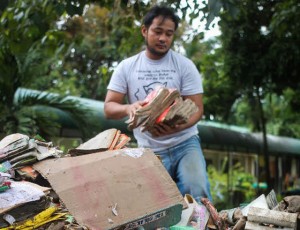A research conducted by the Center for Trade Union and Human Rights (CTUHR), a non-government labor institution, documents how the extended monsoon rains and typhoons tend to worsen poverty, especially of women in urban poor communities, and make it harder for them to ever ‘recover.’
According to the results of the group’s climate justice feminist participatory action research (CJ-FPAR), women and their family members not only bear a heavier burden when their homes and properties are damaged by massive inundation during typhoons or prolonged southwest monsoon rains, they also lose precious working days.
This immediately translates to lower family income amid the calamities, the CTUHR said.
The group conducted their research from February last year to April this year in urban poor communities along the Tullahan River in Metro Manila, covering parts of eight villages in the cities of Malabon, Valenzuela, Caloocan and Quezon City. The Tullahan River is a main waterway that frequently overflows and causes flooding in the communities near it during typhoons and monsoon rains.
In these areas, the researchers note that livelihood and jobs are scarce. Although the said areas host a “factory hub of a wide range of light industries,” mostly owned by Filipinos or Filipino-Chinese, these employ mostly male workers.
But their conditions in these factories are “generally worse than the standard,” the researchers noted in their report.
A month after they concluded their research, as they were writing down their findings, the same observation about the worse job conditions in the area was exposed following the biggest factory fire casualty in Kentex Manufacturing Corp., a rubber slippers factory in Valenzuela.
Fact-finding missions and inspections were separately held after the fire by non-government organizations and also by the Labor Department, revealing the prevalence of violation of labor standards in these factories.
“Regular workers are a rare breed as most employees are contractual with only three to five months work contract,” the CTUHR researchers said in their report.
In these factories, they added, it is commonplace that workers work for 12 hours daily, without day off, without overtime pay, and often, also without social security benefits.
“Most women in communities along Tullahan River are housewives with husbands working either as drivers of public transport vehicles, construction workers or factory workers,” said Jane Siwa, researcher from CTUHR who headed this CJ-FPAR.
To help add to family income, some women in communities along Tullahan do laundry, or work as household help, or as home-based subcontracted piece-rate worker (for example, cutting edges of rubber slippers, making pillows, binding notebooks by sewing, among others).
Other women operate a small retail store or re-sell fish or vegetables at the local market. A few others are employed as street sweepers or factory workers, or raising pigs and chicken for their family’s consumption and added income, the researchers said.
In all these jobs, urban poor women earn little, said CTUHR. The piece-rate jobs, they found out, pay so little that the work finished for the whole day by a group of four family members, for example, may only pay a total of P200 ($4.42).
These women covered by the research expressed their wish that the available jobs for family members are not contractual, low paying jobs, which give them little to nothing to fall back on in times of flooding.
And flooding, the residents said, has grown much more frequent, much faster to come even with just a few days of sustained rains, after Typhoon Ondoy.
With the constant flooding during prolonged, heavy rains, the families in urban poor communities whose breadwinners are in precarious jobs see their income further reduced.
The CTUHR report noted also that the problem for those with precarious livelihood and employment is not just the reduced income immediately after the calamities, but also the bleak prospect offered by their situation. “It becomes almost impossible for families to recover from disasters,” said Daisy Arago, executive director of CTUHR.
In conclusion, Arago of CTUHR said, “Extreme weather events such as typhoons and consequent flooding in Metro Manila that occurred repeatedly and more frequently in recent years have aggravated the urban poor’s condition. Combined with poverty wages and informal or contract employment, these disasters will keep the poor ever mired in poverty.”


